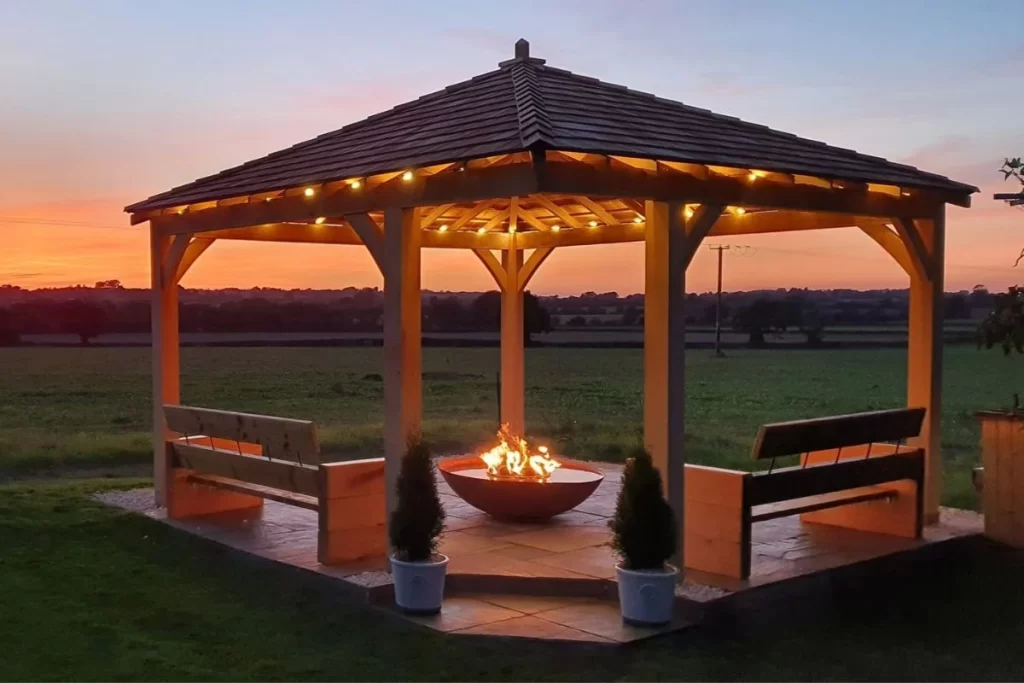
Gazebos have long been cherished as charming outdoor structures that blend functionality with aesthetic appeal. These elegant and versatile pavilions offer a serene retreat from the hustle and bustle of daily life, providing a sheltered space for relaxation, entertainment, and contemplation amidst the beauty of nature.
As we delve into the world of gazebos, it becomes apparent that their designs and styles are as diverse as the landscapes they inhabit. From classic Victorian-inspired structures to sleek and modern designs, gazebos come in a variety of shapes, sizes, and architectural motifs, each reflecting the unique preferences and lifestyles of their owners.
In this exploration of gazebos, we embark on a journey to discover the different types of designs and styles that define these outdoor sanctuaries. From traditional octagonal gazebos to contemporary pergolas and pavilions, we delve into the rich tapestry of gazebos, uncovering their history, features, and distinct characteristics.
Overview of the Article’s Focus on Gazebo Design
In this comprehensive guide, we will delve deeply into the fascinating world of gazebo design, exploring the intricacies, nuances, and considerations that define these beloved outdoor structures. Gazebo design is not merely about creating a shelter; it’s about crafting a space that harmonizes with its surroundings, enhances outdoor experiences, and embodies the unique preferences and lifestyles of its owners.
Throughout this article, we will embark on a journey to unravel the essence of gazebo design, from its historical roots to its modern-day interpretations. We will examine the diverse styles, shapes, and materials that characterize gazebos, exploring how each element contributes to the overall aesthetic and functionality of these outdoor sanctuaries.
Our focus will be on understanding the principles of gazebo design, from the layout and proportions to the architectural details and decorative elements. We will delve into the art of blending form and function, creating spaces that inspire tranquility, foster social connections, and celebrate the beauty of the natural world.
As we explore gazebo design, we will also consider the practical aspects of construction, installation, and maintenance. We will provide insights and tips for selecting the perfect location, choosing the right materials, and ensuring the longevity of your gazebo investment.
Whether you’re dreaming of a classic Victorian gazebo adorned with intricate woodwork, a sleek and modern pavilion with clean lines and minimalist aesthetics, or a rustic pergola enveloped in climbing vines and flowers, this article will offer guidance and inspiration to help you bring your vision to life.
Functional Versatility: Understanding the Many Uses of Gazebos
Gazebos are versatile outdoor structures that serve a multitude of purposes, enriching outdoor spaces and enhancing the overall experience of homeowners and guests alike. Understanding the diverse uses of gazebos sheds light on their importance and appeal in various contexts. Here are several long points elaborating on the many functions of gazebos:
Outdoor Entertaining: Gazebos provide an ideal setting for outdoor entertaining, offering a sheltered space where guests can gather, socialize, and enjoy meals in a comfortable and inviting environment.
Relaxation and Meditation: Gazebos serve as tranquil retreats where individuals can unwind, meditate, or simply enjoy moments of solitude amidst the beauty of nature, fostering a sense of peace and serenity.
Garden Focal Point: Gazebos often serve as focal points in gardens, parks, and landscaped areas, adding visual interest and architectural charm while complementing the surrounding vegetation and landscape design.
Outdoor Dining: Gazebos create intimate dining areas where families and friends can enjoy al fresco meals, barbecues, and picnics, providing a unique and memorable dining experience in the comfort of their own backyard.
Wedding Ceremonies and Events: Gazebos are popular venues for wedding ceremonies, vow renewals, and other special events, offering a picturesque backdrop for exchanging vows and creating lasting memories with loved ones.
Outdoor Workspaces: Gazebos can be transformed into outdoor workspaces or studios, providing a peaceful and inspiring environment for artists, writers, and professionals to pursue their creative endeavors while connecting with nature.
Hot Tub Enclosures: Gazebos offer a private and sheltered space for housing hot tubs and spas, allowing homeowners to enjoy therapeutic relaxation and hydrotherapy treatments in all seasons and weather conditions.
Children’s Play Area: Gazebos can be repurposed as children’s play areas or outdoor classrooms, providing a safe and shaded environment for imaginative play, storytelling, and educational activities.
Outdoor Fitness Center: Gazebos can accommodate outdoor fitness equipment, yoga mats, and exercise classes, encouraging physical activity and wellness while enjoying the fresh air and natural surroundings.
Observation Deck: Elevated gazebos with panoramic views serve as observation decks, allowing individuals to admire scenic vistas, watch wildlife, and stargaze in the evening hours, fostering a deeper connection with the natural world.

Types of Gazebos: Discovering Different Designs and Styles
Gazebos come in a diverse range of designs and styles, each offering its own unique aesthetic and functional features. Exploring the various types of gazebos allows homeowners to find the perfect match for their outdoor space and personal preferences. Here are several detailed points highlighting the different designs and styles of gazebos:
Traditional Octagonal Gazebos: Octagonal gazebos are classic in design, featuring eight sides and a domed or pagoda-style roof. These timeless structures exude elegance and charm, making them popular choices for traditional and formal gardens.
Rectangular or Square Gazebos: Rectangular or square gazebos offer a more contemporary and modern look, with clean lines and geometric shapes. These gazebos provide ample space for seating, dining, and entertaining, making them versatile options for outdoor living areas.
Pergolas: Pergolas are open-air structures with a framework of vertical posts and cross beams, often adorned with climbing vines or fabric canopies. These airy and light-filled structures create a sense of openness and connection with the surrounding landscape, making them ideal for garden settings and outdoor dining areas.
Victorian Style Gazebos: Victorian-style gazebos feature intricate woodwork, decorative trim, and ornate details inspired by the Victorian era. These lavish and ornamental structures add a touch of old-world charm and sophistication to gardens, parks, and historic estates.
Modern Pavilion Gazebos: Modern pavilion gazebos boast sleek lines, minimalist design, and contemporary materials such as metal, glass, and composite decking. These stylish and streamlined structures offer a seamless blend of indoor and outdoor living, providing comfortable and functional spaces for relaxation and entertainment.
Rustic Timber Gazebos: Rustic timber gazebos showcase the natural beauty of wood, with exposed beams, rough-hewn posts, and cedar shingles evoking a sense of rustic charm and warmth. These cozy and inviting structures create a rustic retreat in backyard settings, blending harmoniously with natural surroundings.
Asian-inspired Pagodas: Pagoda-style gazebos draw inspiration from Asian architecture, featuring tiered roofs, curved eaves, and intricate lattice work. These exotic and elegant structures add a touch of exoticism and serenity to garden landscapes, creating tranquil spaces for meditation and contemplation.
Contemporary Metal Gazebos: Contemporary metal gazebos offer a modern and industrial aesthetic, with sleek lines, angular shapes, and durable materials such as aluminum or steel. These minimalist structures provide a striking focal point in urban gardens and rooftop terraces, offering shade and shelter in style.
Portable Pop-Up Gazebos: Portable pop-up gazebos are lightweight and easy to assemble, making them convenient options for outdoor events, festivals, and backyard gatherings. These versatile structures offer temporary shelter from the sun and rain, providing flexibility and mobility for various occasions.
Customized Gazebos: Customized gazebos allow homeowners to personalize their outdoor space with unique features, sizes, and materials tailored to their specific needs and preferences. From built-in benches and fire pits to screened-in enclosures and multi-level decks, customized gazebos offer endless possibilities for creating the perfect outdoor retreat.
Building Your Gazebo: Step-by-Step Guide to Installation and Construction
Building a gazebo requires careful planning, attention to detail, and a systematic approach to ensure a successful construction process. Here is a detailed step-by-step guide to help you navigate the installation and construction of your gazebo:
Selecting the Perfect Location:
- Choose a level and well-drained area in your yard or garden for optimal stability and drainage.
- Consider factors such as sunlight exposure, privacy, and proximity to existing structures when selecting the location for your gazebo.
Obtaining Necessary Permits:
- Check local building codes and regulations to determine if permits are required for building a gazebo in your area.
- Obtain the necessary permits from your local building department before beginning construction to ensure compliance with regulations.
Gathering Materials and Tools:
- Create a list of materials needed for building your gazebo, including lumber, fasteners, roofing materials, and decorative elements.
- Gather the necessary tools for construction, such as a saw, hammer, drill, level, measuring tape, and safety gear.
Preparing the Site:
- Clear the area of any debris, vegetation, or obstacles that may obstruct the construction process.
- Use a shovel or excavator to level the ground and remove any rocks or roots that could interfere with the foundation.
Building the Foundation:
- Decide on the type of foundation for your gazebo, such as concrete footings, wooden posts, or patio stones.
- Dig holes for the foundation according to the specifications of your gazebo plans, ensuring proper spacing and depth for stability.
Assembling the Gazebo Frame:
- Lay out the pre-cut lumber according to the gazebo plans, ensuring accurate measurements and alignment.
- Assemble the frame components, including posts, beams, and rafters, using the appropriate fasteners and techniques.
Installing Roofing and Flooring:
- Choose roofing materials such as shingles, metal panels, or thatch to match the style and aesthetics of your gazebo.
- Install the roofing material according to manufacturer instructions, ensuring proper overlap and waterproofing.
- Consider options for gazebo flooring, such as wood decking, stone pavers, or concrete slabs, based on your preferences and budget.
Adding Decorative Elements:
- Enhance the aesthetics of your gazebo with decorative elements such as trim, molding, lattice panels, and decorative brackets.
- Consider incorporating features like built-in benches, planters, or trellises to customize your gazebo and enhance its functionality.
Applying Finishing Touches:
- Apply a weather-resistant finish or stain to protect the wood and enhance its natural beauty.
- Seal joints and seams with caulk or silicone to prevent water infiltration and ensure durability over time.
Final Inspection and Maintenance:
- Conduct a thorough inspection of your gazebo to ensure structural integrity and compliance with building codes.
- Perform regular maintenance tasks such as cleaning, painting, and sealing to preserve the appearance and longevity of your gazebo.
- By following these step-by-step instructions, you can confidently embark on the construction of your gazebo, creating a beautiful and functional outdoor retreat that brings joy and relaxation to your home and garden.

Gazebo Maintenance: Keeping Your Outdoor Haven in Top Condition
Maintaining your gazebo ensures its longevity, functionality, and aesthetic appeal over time. Here are several detailed points outlining key maintenance tasks to keep your outdoor haven in top condition:
Regular Cleaning:
- Clean the gazebo regularly to remove dirt, debris, and organic matter that can accumulate on surfaces.
- Use a mild detergent or soap and water solution to scrub the wood, metal, or vinyl components of the gazebo.
- Rinse thoroughly with clean water to remove soap residue and prevent staining or discoloration.
Inspecting for Damage:
- Conduct periodic inspections of the gazebo structure, including posts, beams, rafters, and roofing materials.
- Look for signs of damage such as rot, decay, insect infestation, or rusting metal components.
- Address any issues promptly to prevent further deterioration and ensure the structural integrity of the gazebo.
Repairing and Replacing Components:
- Repair or replace damaged or deteriorating components of the gazebo, such as cracked or warped wood, loose fasteners, or torn roofing materials.
- Use high-quality materials and techniques to ensure proper repairs and prevent future issues.
- Consider hiring a professional contractor for complex repairs or structural modifications that require specialized skills and equipment.
Sealing and Waterproofing:
- Apply a weather-resistant sealant or waterproofing product to protect the wood and extend its lifespan.
- Pay particular attention to areas prone to water exposure, such as joints, seams, and end grains, to prevent moisture infiltration and rotting.
- Reapply sealant or waterproofing as needed, especially after heavy rainfall or prolonged exposure to the elements.
Treating Wood Surfaces:
- Treat wooden surfaces with a wood preservative or protective coating to enhance durability and resistance to weathering.
- Choose a product specifically formulated for outdoor use and compatible with the type of wood used in your gazebo.
- Follow manufacturer instructions for application and reapplication to ensure maximum effectiveness and longevity.
Managing Vegetation and Surroundings:
- Trim back overhanging branches, vines, and vegetation that may come into contact with the gazebo structure.
- Keep the area around the gazebo clear of debris, leaves, and plant material to prevent moisture buildup and pest infestations.
- Consider installing landscape fabric or weed barriers under the gazebo to minimize weed growth and maintain a tidy appearance.
Inspection of Hardware and Fasteners:
- Check the integrity of hardware, fasteners, and connectors used in the construction of the gazebo.
- Tighten loose screws, bolts, and nails to ensure structural stability and prevent components from coming loose over time.
- Replace any corroded or rusted hardware with stainless steel or galvanized equivalents to prevent deterioration and maintain strength.
Conclusion
In conclusion, gazebos stand as timeless symbols of beauty, functionality, and relaxation in outdoor spaces. Throughout this guide, we’ve explored the diverse uses, designs, construction processes, and maintenance practices that contribute to the allure and longevity of gazebo

